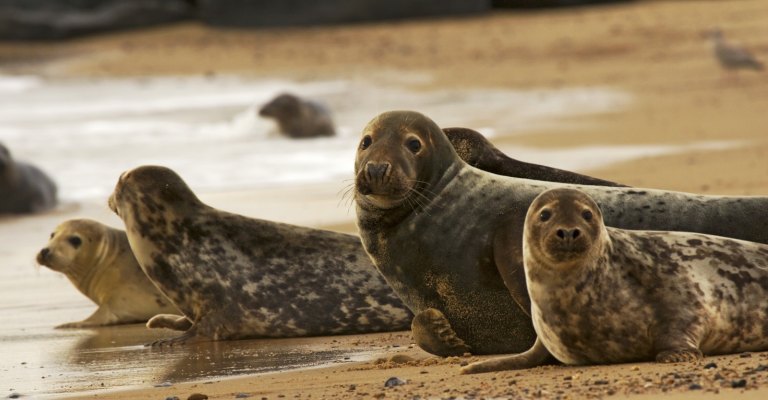Beautiful Beaches
Norfolk's gorgeous beaches were made for bucket-and-spade holidays. With 90 miles of pristine coastline, you'll have a fantastic time discovering a new favourite beach every day whether your perfect day features sand castles and ice creams at Cromer, or bird spotting in the salt marsh of Holme-next-the-Sea. Horsey's grey seal population is one of the largest in Europe, and you can see the seals (and often their pups) by following the National Trust walk from Horsey Windpump to the beach. There's also Great Yarmouth, and you may want to consider Mundesley with its pretty colourful wooden huts; Gorleston-on-Sea which is very family friendly; and Winterton-on-Sea with a huge golden beach backed by dunes (you can walk along the beach from Winterton-on-Sea to Horsey to see the seals, then return to the café on the beach to refuel - we can personally recommend the crab sandwiches!).

Kings Lynn
With all the beauty of the beaches and the Broads, West Norfolk doesn't garner as much attention in tourist guides. To overlook the wonderful west would be a huge mistake because it's just as lovely as the rest of the county. Kings Lynn offers lots for visitors. Its history as one of the most important medieval ports is evident in the layout of the cobbled lanes where the merchants lived in their fine houses, the grandeur of St Margaret's Church, and the fancy design of the market square. There are lots of places to shop and eat, especially if you're there for the Tuesday market.
Great Yarmouth

For a quintessentially British seaside holiday, look no further than Great Yarmouth. It has all the right ingredients: a clean sandy beach; a seafront lined with shops selling beach balls and sweet sticks of rock; ice cream shops and cafes; and amusement arcades in which to spend pocket money on the games or take shelter from a summer shower. There are bowling greens and a theatre, donkey rides and mini golf, a large park and the Pleasure Beach Gardens. Sandwiched between the ocean and the River Yare, Great Yarmouth is the stuff of which traditional family holiday dreams are made.
The Wash
If you're near Kings Lynn, you should take a detour to The Wash. The estuary, which is the largest in the UK, faces the North Sea and is home to a plethora of birds and wildlife which enjoy the food and shelter provided by a variety of terrain including mudflats, shingle and sand dunes. It's particularly busy in winter when 300,000 visiting birds make it their seasonal feeding ground, and when seals choose the sand banks as a maternity ward for their pups. Anglers should try fishing for flounder around Hunstanton and Snettisham.
The Broads

The Norfolk Broads are vast and so fascinating that we've dedicated an entire guide just to the area (things to do in the Norfolk Broads), but there's no way you can talk about discovering Norfolk without at least mentioning them, so they are included here too. One of the nicest ways to experience The Broads is by boat. Navigate your way to places like Hickling or Barton, or simply drift along and dock when you spy a pub or picnic spot you like the look of. Cycling and walking are also popular, and given that the Broads are fairly centrally located in Norfolk, you can easily reach them from wherever you decide to stay.
The Brecks
The Breckland landscape was shaped by the actions of prehistoric farmers, who worked the land until it was barren, when they then moved their crops to a new area and allowed the heath to take over. It is a strangely beautiful scene, not least because, as one of the driest areas in Britain, it often has stunning blue skies. It offers miles of wonderful walking and is home to rare species of wildlife, as well as the only inland sand dunes in the UK. It was inhabited by the Iceni, with Gallows Hill in Thetford being of particular importance, as was Grimes Graves where there are 700 pits dating back nearly 3,000 years.










